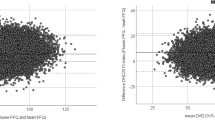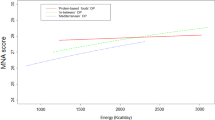Abstract
Background/Objectives:
The EPIC-Soft program (the software initially developed to conduct 24-h dietary recalls (24-HDRs) in the European Prospective Investigation into Cancer and Nutrition (EPIC) Study) was recommended as the best way to standardize 24-HDRs for future pan-European dietary monitoring. Within European Food Consumption Validation (EFCOVAL), EPIC-Soft was adapted and further developed on various aspects that were required to optimize its use. In this paper, we present the structure and main interview steps of the EPIC-Soft program, after implementation of a series of new specifications deemed to satisfy specific requirements of pan-European monitoring surveys and other international studies.
Subjects/Methods:
Updates to optimize the EPIC-Soft program were ascertained according to the following stepwise approach: (1) identification of requested specifications to be potentially implemented through an ad hoc ‘EPIC-Soft specifications questionnaire’ sent to past, current and possible future users of the software; (2) evaluation of the specifications in collaboration with two ad hoc task force groups and through a workshop; (3) development of a technical solution for each retained specification; (4) implementation of the specifications by software developers; (5) testing and amendment of bugs.
Results:
A number of new specifications and facilities were implemented to EPIC-Soft program. In addition, the software underwent a full reprogramming and migration to a modern Windows environment, including changes in its internal architecture and user interface. Although the overall concept and structure of the initial software were not changed substantially, these improvements ease the current and future use of EPIC-Soft and increase further its adaptation to other countries and study contexts.
Conclusions:
EPIC-Soft is enriched with further functions and facilities expected to fulfil specific needs of pan-European dietary monitoring and risk assessment purposes. The validity, feasibility and relevance of this software for different national and international study designs, and the logistical aspects related to its implementation are reported elsewhere.
This is a preview of subscription content, access via your institution
Access options
Subscribe to this journal
Receive 12 print issues and online access
$259.00 per year
only $21.58 per issue
Buy this article
- Purchase on Springer Link
- Instant access to full article PDF
Prices may be subject to local taxes which are calculated during checkout






Similar content being viewed by others
References
Al-Delaimy WK, Ferrari P, Slimani N, Pala V, Johansson I, Nilsson S et al. (2005). Plasma carotenoids as biomarkers of intake of fruits and vegetables: individual-level correlations in the European Prospective Investigation into Cancer and Nutrition (EPIC). Eur J Clin Nutr 59, 1387–1396.
Biró G, Hulshof KF, Ovesen L, Amorim Cruz JA, EFCOSUM Participants (2002). Selection of methodology to assess food intake. Eur J Clin Nutr 56 (Suppl 2), S25–S32.
Brussaard JH, Johansson L, Kearney J, EFCOSUM Participants (2002a). Rationale and methods of the EFCOSUM project. Eur J Clin Nutr 56 (Suppl 2), S4–S7.
Brussaard JH, Löwik MR, Steingrımsdóttir L, Møller A, Kearney J, De Henauw S, EFCOSUM Participants et al. (2002b). A European food consumption survey method—conclusions and recommendations. Eur J Clin Nutr 56 (Suppl 2), S89–S94.
Brustad M, Skeie G, Braaten T, Slimani N, Lund E (2003). Comparison of telephone vs face-to-face interviews in the assessment of dietary intake by the 24 h recall EPIC SOFT program--the Norwegian calibration study. Eur J Clin Nutr 57, 107–113.
Crispim SP, de Vries JH, Geelen A, Souverein OW, Hulshof PJ, Lafay L et al. (2011). Two non-consecutive 24 h recalls using EPIC-Soft software are sufficiently valid for comparing protein and potassium intake between five European centers—results from the European Food Consumption Validation (EFCOVAL) study. Br J Nutr 105, 447–458.
Crispim SP, Geelen A, Le Donne C, De Vries JHM, Sette S, Raffo A, EFCOVAL Participants et al. (2010). Dietary exposure to flavouring substances: from screening methods to detailed assessments using food consumption data collected with EPIC-Soft software. Food Additives & Contaminants: Part A, Volume 27, 433–446.
Elmadfa I, Meyer A, Nowak V, Hasenegger V, Putz P, Verstraeten R et al. (2009). European nutrition and health report 2009. Forum Nutr 58, 1–220.
Ferrari P, Kaaks R, Fahey MT, Slimani N, Day NE, Pera G et al. (2004). Within- and between-cohort variation in measured macronutrient intakes, taking account of measurement errors, in the European Prospective Investigation into Cancer and Nutrition study. Am J Epidemiol 160, 814–822.
Ferrari P, Roddam A, Fahey MT, Jenab M, Bamia C, Ocké M et al. (2009). A bivariate measurement error model for nitrogen and potassium intakes to evaluate the performance of regression calibration in the European Prospective Investigation into Cancer and Nutrition study. Eur J Clin Nutr 63 (Suppl 4), S179–S187.
Freisling H, Fahey MT, Moskal A, Ocké MC, Ferrari P, Jenab M et al. (2010). Region-specific nutrient intake patterns exhibit a geographical gradient within and between European countries. J Nutr 140, 1280–1286.
Huybrechts I, Casagrande C, Nicolas G, Geelen A, Crispim SP, De Keyzer W et al. (2011a). Inventory of experiences from national/regional monitoring surveys using EPIC-Soft. Eur J Clin Nutr 65 (Suppl 1), S16–S28.
Huybrechts I, Geelen A, de Vries JH, Casagrande C, Nicolas G, De Keyzer W et al. (2011b). Respondents’ evaluation of the 24-h dietary recall method (EPIC-Soft) in the EFCOVAL Project. Eur J Clin Nutr 65 (Suppl 1), S29–S37.
Huybrechts I, Sioen I, Boon PE, Ruprich J, Lafay L, Turrini A et al (2010). Dietary Exposure Assessments for Children in Europe (the EXPOCHI project): rationale, methods and design. Arch of Public Health (in press).
Ngo J, Engelen A, Molag M, Roesle J, García-Segovia P, Serra-Majem L (2009). A review of the use of information and communication technologies for dietary assessment. Br J Nutr 101 (Suppl 2), S102–S112.
Ocké MC, Slimani N, Brants H, Buurma-Rethans E, Casagrande C, Nicolas G et al. (2011). Potential and requirements for a standardized pan-European food consumption survey using the EPIC-Soft software. Eur J Clin Nutr 65 (Suppl 1), S48–S57.
Riboli E (1992). Nutrition and cancer: background and rationale of the European Investigation into Cancer and Nutrition (EPIC). Ann Oncol 3, 783–791.
Saadatian-Elahi M, Slimani N, Chajès V, Jenab M, Goudable J, Biessy C et al. (2009). Plasma phospholipid fatty acid profiles and their association with food intakes: results from a cross-sectional study within the European Prospective Investigation into Cancer and Nutrition. Am J Clin Nutr 89, 331–346.
Slimani N, Bingham S, Runswick S, Ferrari P, Day NE, Welch AA et al. (2003). Group level validation of protein intakes estimated by 24-h diet recall and dietary questionnaires against 24-h urinary nitrogen in the European Prospective Investigation into Cancer and Nutrition (EPIC) calibration study. Cancer Epidemiol Biomarkers Prev 12, 784–795.
Slimani N, Deharveng G, Charrondière RU, van Kappel AL, Ocké MC, Welch A et al. (1999). Structure of the standardized computerized 24-h diet recall interview used as reference method in the 22 centers participating in the EPIC project. Comp Meth Prog Biomed 58, 251–266.
Slimani N, Deharveng G, Unwin I, Southgate DA, Vignat J, Skeie G et al. (2007). The EPIC nutrient database project (ENDB): a first attempt to standardize nutrient databases across the 10 European countries participating in the EPIC study. Eur J Clin Nutr 61, 1037–1056.
Slimani N, Ferrari P, Ocké M, Welch A, Boeing H, Liere M et al. (2000). Standardization of the 24-h diet recall calibration method used in the European Prospective Investigation into Cancer and Nutrition (EPIC): general concepts and preliminary results. Eur J Clin Nutr 54, 900–917.
Slimani N, Margetts BM (2009). Nutrient intake and patterns in the European Prospective Investigation into Cancer and Nutrition cohorts from 10 European countries. Eur J Clin Nutr 63 (Suppl 4), S1–S274.
Slimani N, Valsta L, EFCOSUM Group (2002). Perspectives of using the EPIC-Soft programme in the context of pan-European nutritional monitoring surveys: methodological and practical implications. Eur J Clin Nutr 56 (Suppl 2), S63–S74.
Trichopoulou A, Naska III A, DAFNE Group (2003). European food availability databank based on household budget surveys: the Data Food Networking initiative. Eur J Public Health 13 (Suppl 3), S24–S28.
Vereecken CA, Covents M, Matthys C, Maes L (2005). Young adolescents’ nutrition assessment on computer (YANA-C). Eur J Clin Nutr 59, 658–667.
Acknowledgements
The content of this article reflects only our views and the Community is not liable for any use that may be made of the information contained therein. We also thank G & P Grange for software development; all IARC and EPIC collaborators who contributed to the initial or current work on the EPIC-Soft program; and those who responded to the new specification and other questionnaires. The Community funding under the Sixth Framework Program for the EFCOVAL project is acknowledged (FOOD-CT-2006-022895).
Author information
Authors and Affiliations
Consortia
Corresponding author
Ethics declarations
Competing interests
The authors declare no conflict of interest.
Additional information
Contributors: NS, GN, CC and HF contributed to the conception and drafting of the paper by taking into account the comments from all the co-authors. IH, MCO, EMN, CvR, MB, MDM, LL, CK, PA, ET, AG, JHdV and EJdB contributed to the conception of the paper. All of them gave input on the drafting of the manuscript. All authors read and approved the final version.
Appendix A
Appendix A

Rights and permissions
About this article
Cite this article
Slimani, N., Casagrande, C., Nicolas, G. et al. The standardized computerized 24-h dietary recall method EPIC-Soft adapted for pan-European dietary monitoring. Eur J Clin Nutr 65 (Suppl 1), S5–S15 (2011). https://doi.org/10.1038/ejcn.2011.83
Published:
Issue Date:
DOI: https://doi.org/10.1038/ejcn.2011.83
Keywords
This article is cited by
-
Alcohol consumption: context and association with mortality in Switzerland
European Journal of Nutrition (2023)
-
Shifting towards optimized healthy and sustainable Dutch diets: impact on protein quality
European Journal of Nutrition (2023)
-
Daily and meal-based assessment of dairy and corresponding protein intake in Switzerland: results from the National Nutrition Survey menuCH
European Journal of Nutrition (2021)
-
Ten-year changes in diet quality among adolescents and young adults (Food Consumption Survey 2004 and 2014, Belgium)
European Journal of Nutrition (2021)
-
Importance of details in food descriptions in estimating population nutrient intake distributions
Nutrition Journal (2019)



